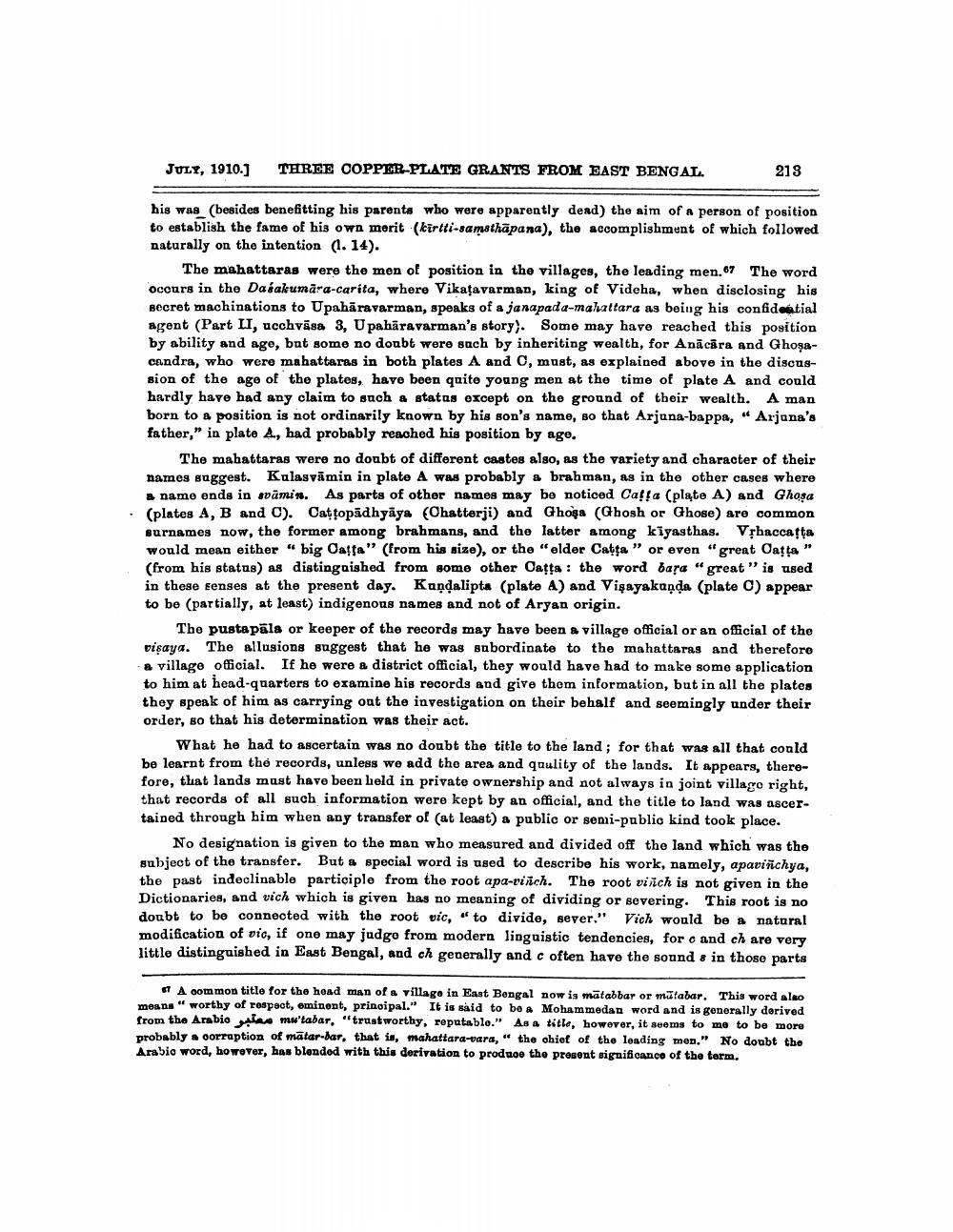________________
JULY, 1910.]
THREE COPPER-PLATE GRANTS FROM EAST BENGAL.
his was (besides benefitting his parents who were apparently dead) the aim of a person of position to establish the fame of his own merit (kirtti-samsthapana), the accomplishment of which followed naturally on the intention (1. 14).
213
The mahattaras were the men of position in the villages, the leading men.67 The word occurs in the Dasakumara-carita, where Vikaṭavarman, king of Videha, when disclosing his Becret machinations to Upaharavarman, speaks of a janapada-mahattara as being his confidential agent (Part LI, ucchväsa 3, Upahāravarman's story). Some may have reached this position by ability and age, but some no doubt were such by inheriting wealth, for Anācāra and Ghosacandra, who were mahattaras in both plates A and C, must, as explained above in the discussion of the age of the plates, have been quite young men at the time of plate A and could hardly have had any claim to such a status except on the ground of their wealth. A man born to a position is not ordinarily known by his son's name, so that Arjuna-bappa, "Arjuna's father," in plate A, had probably reached his position by age.
The mahattaras were no doubt of different castes also, as the variety and character of their names suggest. Kulasvamin in plate A was probably a brahman, as in the other cases where a name ends in svamin. As parts of other names may be noticed Caffa (plate A) and Ghosa (plates A, B and C). Caṭṭopadhyaya (Chatterji) and Ghosa (Ghosh or Ghose) are common surnames now, the former among brahmans, and the latter among kiyasthas. Vṛhaccaṭṭa would mean either "big Catta" (from his size), or the "elder Caṭṭa" or even 'great Catta (from his status) as distinguished from some other Caṭṭa: the word bara "great" is used in these senses at the present day. Kandalipta (plate A) and Visayakanda (plate C) appear to be (partially, at least) indigenous names and not of Aryan origin.
68
The pustapala or keeper of the records may have been a village official or an official of the visaya. The allusions suggest that he was subordinate to the mahattaras and therefore a village official. If he were a district official, they would have had to make some application to him at head-quarters to examine his records and give them information, but in all the plates they speak of him as carrying out the investigation on their behalf and seemingly under their order, so that his determination was their act.
What he had to ascertain was no doubt the title to the land; for that was all that could be learnt from the records, unless we add the area and quality of the lands. It appears, therefore, that lands must have been held in private ownership and not always in joint village right, that records of all such information were kept by an official, and the title to land was ascertained through him when any transfer of (at least) a public or semi-public kind took place.
No designation is given to the man who measured and divided off the land which was the subject of the transfer. But a special word is used to describe his work, namely, apaviñchya, the past indeclinable participle from the root apa-rinch. The root viñch is not given in the Dictionaries, and vich which is given has no meaning of dividing or severing. This root is no doubt to be connected with the root vic, "to divide, sever." Vich would be a natural modification of vic, if one may judge from modern linguistic tendencies, for e and ch are very little distinguished in East Bengal, and ch generally and c often have the sounds in those parts
67 A common title for the head man of a village in East Bengal now is matabbar or mutabar. This word also means "worthy of respect, eminent, principal." It is said to be a Mohammedan word and is generally derived from the Arabicas mu'tabar, "trustworthy, reputable." As a title, however, it seems to me to be more probably a corruption of matar-bar, that is, mahattara-vara," the chief of the leading men." No doubt the Arabic word, however, has blended with this derivation to produce the present significance of the term.




